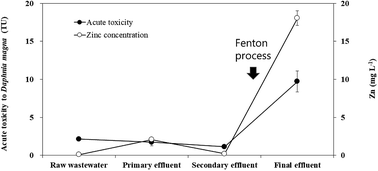Effect of low-purity Fenton reagents on toxicity of textile dyeing effluent to Daphnia magna
Abstract
This study aimed to identify the source of toxicity in textile dyeing effluent collected from February to July 2016, using Daphnia magna as a test organism. Toxicity identification evaluation (TIE) procedures were used to identify the toxicants in textile dyeing effluent, and Jar testing to simulate the Fenton process was conducted to identify the source of toxicants. Textile dyeing effluent was acutely toxic to D. magna [from 1.5 to 9.7 toxic units (TU)] during the study period. TIE results showed that Zn derived from the Fenton process was a key toxicant in textile dyeing effluent. Additionally, Jar testing revealed that low-purity Fenton reagents (FeCl2 and FeSO4), which contained large amounts of Zn (89 838 and 610 mg L−1, respectively), were the source of toxicity. Although we were unable to conclusively identify the residual toxicity (approx. 1.4 TU of 9.71 TU) attributable to unknown toxicants in textile dyeing effluent, the findings of this study suggest that careful operation of the Fenton treatment process could contribute to eliminating its unintended toxic effects on aquatic organisms.

- This article is part of the themed collection: Bioanalytical tools for water and sediment quality assessment


 Please wait while we load your content...
Please wait while we load your content...